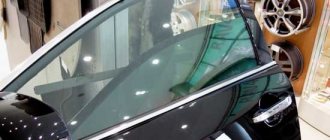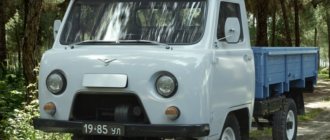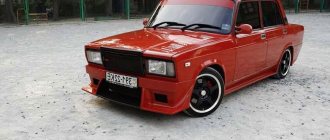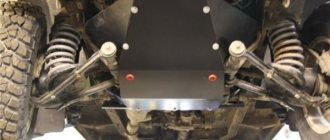A differential is a device designed specifically to transmit the so-called torque from a car engine to its wheels using transmission elements. A free differential, installed on vehicles during assembly at the factory, cannot affect the other when one of the wheels slips. Differential locking can help achieve different wheel speeds when necessary (for example, on poor, usually dirt roads). It increases torque on one of the wheels, usually the one with the best traction. To achieve this result, a self-locking differential is used. An alternative option could be a forced blocking method. It is important to understand whether it is worth installing a self-locking differential on the Niva, what this will do for the car and how to carry out the installation of the device.
Why do you need a self-block for Niva?
The presence of all-wheel drive in a car does not always give it the status of an all-terrain vehicle. Sometimes, due to the nature of their design, vehicles designed for off-road driving can become trapped on washed out roads. A self-locking differential is an important component of the car if the driver plans to use his Niva to drive on bad roads.
What is a self-block, or limited slip differential? This is a device that ensures wheel locking, and automatically, at the right time. It is an intermediate option between a full lock and a free differential. The self-block combines the capabilities of both of these devices.
In what situations should you use blocking?
If the car is moving on a normal road, there is no need to engage the lock. And if you go onto a country road or find yourself facing a steep climb, then the driver must be on the safe side. It follows from this that the blocking system should only be used in situations where an obstacle appears in front of the driver while driving. It is best to do this in advance so that the car does not get stuck, especially since the process of turning on the lock does not take much time.
And at the same time, it is necessary to remember that if you use the blocking system unnecessarily, this will not lead to the safety of the vehicle: excessive consumption of gasoline begins to occur, and tires also wear out.
Types of mechanisms
There are two main types of self-locking differentials, which include several more subtypes. The first type is devices that lock depending on the angular velocities on the vehicle axles. They can be:
- disk;
- with viscous coupling;
- with electronic locking.
The second type is mechanisms that lock depending on the torques on the axes. These include worm differentials.
There are also center and cross-axle differentials. They involve the distribution of torque between the axles and wheels, respectively. Depending on the moment of distribution attributable to the axles or wheels, symmetrical and asymmetrical types of mechanisms are distinguished. On vehicles called all-wheel drive, three types of differentials are installed at once: two of them are interwheel, and one is interaxle.
On the Niva it is possible to install electronic, mechanical (it is a conventional mechanism combined with a viscous coupling), and pneumatic differentials.
The electronic self-block has a very big advantage. To use it, just press a button. It works in automatic mode, but only when the car is traveling at a certain speed, which is below a threshold value. The system turns off when the speed exceeds the set speed.
The pneumatic differential is a mechanism mounted on two axles. The advantage is compactness. In its work it uses pneumatic systems.
The mechanical self-block is the simplest in its design; it is cheaper than pneumatic and electronic devices. The mechanism consists of two semi-axial and two spacer couplings, pins and springs. Quite a reliable design, despite its simplicity.
Functional purpose of the device
A rigid blocking is used on the Niva to balance the incoming load. The process is based on the unevenness of the path traveled by each wheel. The sides located closest to the center travel several times shorter than the wheels located on the outer side. At low travel speeds, some of the rubber wears out faster, and at high speeds, skidding occurs.
Electronic differential locking helps to avoid the above. In good condition, it transmits torque from 1 source to 2 different consumers. In order to understand how the mechanism works, it is necessary to imagine the following: from 1 source, each consumer receives a torque of different physical parameters. If the differential lock is set correctly, the difference in the amount of torque received ensures safe rotation of the wheels along the inner and outer radius. Physical wear and tear or mechanical damage increases the likelihood of a skid accident. When operating the VAZ 2121 on roads with unsatisfactory surface quality, the importance of the differential increases.
All-wheel drive vehicles, whose axles are coordinated by a differential, distribute torque evenly to all wheels. In case of slipping, the system automatically transfers maximum torque to them. The switching process does not take much time. In the event of a malfunction, 2 wheels slip, while the other 2 remain stationary. Differential locking helps to avoid this.
It forcibly distributes torque evenly over the front axle, between it and the axles. In case of temporary slipping, the device will provide the necessary uniform force to increase the quality of traction.
Characteristics and selection rules
The choice of a self-locking differential is determined by the car model, its operating conditions, driving style and many other parameters. For example, a ball differential increases steering load, which actually changes the driving style of whoever is behind the wheel. This is mainly felt when making U-turns and turns, but can lead to breakdowns of transmission components.
If you approach the choice of a self-block correctly, then you need to take into account which axle of the car the mechanism will be installed on, since the number of splines for different models is different - twenty-two or twenty-four.
The marking on the device packaging will tell you whether it can be used for a given car brand. The blocking coefficient also varies: for example, 0.5 or 0.7. These numbers show the amount of torque transmitted. What to choose is up to the driver.
Varieties
There are two main groups of self-locking differentials. The first type works depending on the angular speed parameters along the axes of the vehicle. In turn, these modifications are divided into several subtypes, namely:
- disk versions;
- models equipped with a viscous coupling;
- options with electronic action.
The second type includes mechanisms that are locked in accordance with the torsional moments on the axes. This group includes worm modifications.
Pros and cons of installing a differential on Niva
If you compare the self-block and the standard Niva differential, you can identify the negative and positive aspects of replacing the latter. First, about the advantages:
- Increases the vehicle's cross-country ability, making it suitable for driving on steep, slippery and uneven sections of the road.
- It is mounted instead of the original differential and does not change the design of the car. It is better to carry out the installation at a car service center, but it is quite easy to do it yourself.
- The full differential operates automatically during the driving process, without requiring additional actions or any driver training.
Now about the disadvantages of installing the mechanism:
- The steering wheel becomes tighter, which will require additional effort from the person sitting behind it when driving.
- The service life is shorter than that of the differential supplied to the vehicle by the factory.
- It slightly modifies the control of the car when turning, does not provide an absolute guarantee of locking, however, like the standard mechanism.
Different models of self-locking differentials have their own nuances, which largely depend on the manufacturer, the novelty of the development, and the components used.
DIY self-block installation instructions
To install a self-locking differential on a Niva, it is not necessary to contact a car service center. It is quite possible to do this with your own hands, provided that the person has a good understanding of the structure of the car. The type of differential and its installation location are not particularly important.
First you need to decide on the place where the work will be done; it should be spacious enough. Using several jacks, you will need to lift the Niva, dismantle the wheels, then drain the engine oil from the gearbox housing into some container and remove the drive axle drive. To do this, just use a spanner to unscrew all the nuts securing the front cover to the gearbox housing, remove the cover and gasket.
Now it is necessary to reliably and efficiently carry out the operation of dismantling the axle shafts, which is very difficult to do without a special puller. The metal is clamped on rotary slots, which requires a lot of effort, which not every person has enough. Dismantling the axle shafts is carried out as follows:
- Unscrew all the bolt nuts on the axle bearing mounting plate.
- The brake mechanism is fixed. This can be done using bolts or wire. If the mechanism is not secured, the brake lines may come off.
- The axle shaft itself is removed. With sufficient skill, this can be done by hand, but it is better with the help of a puller.
Then you need to change the bearings. This will require a hydraulic press. It will help ensure that the holder fits onto the shaft, and with fairly high accuracy. To replace you need:
- Unscrew the hub bearing nut and remove the bushing. Unscrew the nut securing the lever to the steering knuckle.
- Remove the locking plate and unscrew the lever from the steering knuckle.
- Having disconnected all the fasteners, separate the knuckle and the hub with the brake disc. Remove the bearing by first holding the steering knuckle in a vice. During assembly, the bearing is put on using a press.
After the clearances in the main gear are adjusted using special washers of variable thickness, you can begin assembling the unit. Adjusting the gaps is quite difficult, and you will need special equipment, but to ensure accuracy you can use a steelyard. To work with it, wind one end of a 1 m long cord around the flange and secure the other end to the scales. By pulling the device in the winding, you will need to record the turning moment.
To ensure proper operation of the gearbox, the parts are usually sealed before the halves are assembled. In its absence, malfunctions may occur during operation, as well as failure of certain spare parts. After applying the sealant, you need to wait a while for it to harden. Then new oil should be poured into the gear housing. All sealing joints that were damaged during dismantling, as well as those that show signs of oil leakage, must be completely replaced with new ones. Now you can start assembling all the mechanisms in reverse order.
After completing all the replacement and installation of parts, you must check the operation of the devices that provide vehicle braking. Their malfunction may affect road safety.
The feasibility of such an action as differential locking on a Niva depends on why the driver needs it. If you need to move through difficult areas, you will need it. If a car enthusiast intends to drive on a normal asphalt road, then installing a self-locking differential on the Niva is hardly worth it. Which self-block to choose and where to place it depends on the driver’s preferences.
If desired, you can lock the differential with your own hands in the drive axle gearbox of any car. A driver who uses his car exclusively on paved roads will most likely never have the desire to lock the differential. Another thing is for those who like to conquer off-road terrain.
Dealers and service centers
50 partner stores and 7 services in Russia
7. Distribution of torques in the transfer case
The question comes up quite often. Misunderstanding arises due to the fact that completely different physical phenomena are confused: force (moment) and motion (rotation).
First, a few starting points.
1. An unlocked symmetrical differential distributes the torque coming from the input shaft to the output shafts exactly equally: 50/50. This follows from the fact that the gear ratios from the input shaft to the output shaft are the same. In this case, the output shafts can rotate at different speeds, but the average speed (half the sum of the speeds) is equal to the speed of the input shaft divided by the gear ratio.
2. A locked differential ceases to be a differential. The movement (rotation) of the input shaft is transmitted equally to the output shafts. The speeds of the output shafts are equal to each other, and their sum is equal to the speed of the input shaft divided by the gear ratio.
3. If the total torque applied to the shaft (wheel) is not zero, the rotation will be accelerated or decelerated. This is Newton's second law. If the shaft or wheel rotates uniformly, the total torque acting on it is exactly zero. The absence of movement is also uniform rotation, but with zero speed.
There are three symmetrical differentials in the field. When they are all unlocked, each wheel receives 25% of the torque transmitted through the transmission from the engine. And the rotation generated by the engine is also transmitted to all four wheels, but not necessarily equally. For example, when turning, the rear wheels travel a shorter distance (smaller radius) than the front wheels, but all four wheels pull equally.
Let's consider a situation where one wheel is slipping, the rest are standing. All engine rotation is transmitted to the slipping wheel. Strange as it may seem at first glance, the slipping wheel accounts for 25% of the torque, exactly the same as the rest. But this moment is small: it is equal to the moment of friction (only in the transmission, if the wheel is completely suspended). This means that the moment on the other wheels is also very small, it cannot move the car. The car is stationary, and the suspended wheel rotates at a speed that is four times higher than it would be during normal movement at speed at the same engine speed and with the same gears in the gearbox and transfer case.
Automatic or manual
Only the car owner must decide which lock to choose: full or partial.
Full differential locking can be manual or automatic.
Partial differential limitation operates only in automatic mode.
Full blocking
With this type of mechanism limitation, the difference in the rotation speed of the axle shafts is not provided for, which leads to increased wear of transmission elements and tires on hard road surfaces, and to slipping off-road. To control the locking device, you will need to install a manual drive.
Manual lock
With manual limitation, the existing speed difference will be replaced - you just need to press a special button to activate the external source.
The selective blocking system is a complex mechanism with certain variations. To make changes to the operation of the differential, the movement must be stopped. When the limitation is disabled, the axle behaves normally and does not affect driving in any way. Such blocking will not be cheap, since it will require installing a separate system to activate the mechanism.
Automatic blocking
Automatic locking will always work when the driver's foot is on the gas pedal. This makes it possible to constantly keep your hands on the steering wheel and concentrate on driving. This limitation must be adjusted to the driving style of a particular person.
Partial blocking
For non-extreme drivers, partial blocking in the car is quite enough. This mechanism works independently; it only partially eliminates wheel slip and puts less load on the transmission than a complete lock.
Such a limitation can be using friction discs or helical gears.
Forced differential locking on Niva
What is a differential lock in a field? The center differential is good. But conditions may arise under which only one wheel out of four will rotate. What's the point of all-wheel drive? Tolyatti designers foresaw this. The Niva is equipped with a forced locking of the center differential. This means that the driver, if necessary, can equalize the speeds of both axles. Thus, one wheel will constantly rotate on different axles, as a result, the vehicle’s maneuverability is significantly increased. But forced locking can only be used off-road. By the way, some drivers do not really delve into the design of the Niva and mistakenly believe that by switching the small lever back, they engage the front axle. No, this handle just blocks the center differential.
For reasons of cross-country ability, it would be very good if all 4 wheels rotated, even for a short time. In this case, the car would be little inferior to the tractor. But the Niva has a so-called free inter-wheel differential, i.e. torque is alternately supplied to one of the wheels and forced locking is not provided for the Niva.
Moreover, the Chevrolet Niva does not have such a block either.
Buying hand winches for cars: secrets of selection.
Are you thinking about tuning the Toyota Land Cruiser Prado 150 for different situations? This material will help you with this.
The best mud tires for Niva and other SUVs: how to choose the right one.
The American concern liked the transmission so much that they transferred it to the joint car with almost no changes. “Almost” - because GM designers combined control of the transfer case and forced differential locking. The result is two levers instead of three. Patriotic owners of domestic SUVs, by the way, consider the convenience of such innovation doubtful. Another change affected the mounting of the transfer case. Thanks to its new supports, vibration in the cabin has become much less.
Self-locking system
Can be configured to the required switching threshold. This can be either a slight slip or uneven distribution of torque among the wheels. Such a connection is not rigid, and therefore does not place unnecessary load on the interaxial connection.
When installing a forced locking system on a Chevrolet Niva, you should remember that a constantly turned on system can put unnecessary stress on the transmission, so you should turn it on only when overcoming difficult sections of the road.
Forced locking of the cross-axle differential on Niva
The VAZ SUV was developed as a car for the village. At the time, it was said that additional interlocks would complicate the design, making it more expensive and less reliable. In addition, the Niva already has good cross-country ability. This is probably correct. However, in a country where the percentage of paved roads out of the total number is relatively small, we want more.
Various small and large enterprises took advantage of this, mastering the production of differentials with forced locking. The following should be noted immediately . Therefore, before converting a car, you need to weigh everything carefully and be sure to consult with specialists.
And, nevertheless, since such a rework is possible, it is necessary to say a few words about it. Currently, the most common differentials are:
- With pneumatic connection;
- With electrical connection;
- Self-locking.
Briefly - the advantages and disadvantages of each of them.
Pneumatic connection.
The wheels are locked from inside the car using compressed air. In this case, a silicone hose is laid to the car axle. The device is quite reliable, but requires additional expensive equipment. A set of hoses, a compressor and a receiver are sometimes more expensive than the differential itself.
Electrical connection
The differential gear is locked by a cam mechanism, which is activated by electromagnets. The device is reliable and does not require maintenance. The downside is the high current consumption, which places additional demands on electrical equipment.
Self-locking mechanisms
Their operating principles are different. Some are blocked at the slightest slip, others when the load on the wheels increases. However, regardless of the design, they do not require human intervention, and therefore are popular among SUV owners. But their main advantage is that they do not have such a rigid locking as all other types, which means they partially remove additional load from the axle shafts.
How to do
The easiest way is to permanently lock the differential completely. But such a homemade blocking is acceptable for cars driving only off-road. For example, for rally-raid cars. To implement the idea, you need to remove the unit equipped with the differential and disassemble it. Then weld the satellites to the axles. Fixing the gears will allow the mechanism to divide the rotation speed between the axle shafts only in a ratio of 50 to 50. Making a limited slip differential with your own hands is a little more difficult than simply fixing the satellites. But such a modernization will not only improve the vehicle’s maneuverability in mud and snow, but will also not change the operation of the unit on hard surfaces. One version of such a device can be assembled from two brass or bronze bushings and a spring. Their sizes will depend on which vehicle transmission you are upgrading. Therefore, work begins with removing the assembly and disassembling the planetary gear. After this, you can take measurements, order the production of bushings and select a spring of suitable dimensions.
You will find out whether it is stiff enough after assembly by testing your homemade product. The spring is designed to press the pinion gears against the differential housing. Because of this, under the influence of friction, the satellites will rotate more slowly around their axis. The greater the friction force, the more evenly the speed of rotation of the driveshaft will be divided between the axle shafts. Metal bushings are needed to prevent contact of the satellites with the spring.
Of course, installing a factory-made differential lock is easier and the result of such an upgrade is better. However, it is expensive and practically eliminates creativity from the process. The cost of “self-blocks” for cars of the VAZ family is slightly less than 12 thousand rubles. But their installation requires only care and accuracy. There is no need for a special tool.
Which lock is better?
The answer to this question depends on what kind of car you have and where you drive it. Therefore, let’s say just a few words about the features of different types of blocking.
- Forced manual locking. The advantage is that it is completely turned on and off at the right time and, as a result, better cross-country ability of the vehicle. The disadvantages include the need for advance switching on and mandatory switching off.
- Automatic blocking. Switching on and off without driver intervention is a definite advantage. Noticeable inertia is its obvious drawback.
What to choose
The task is quite difficult, given the wide variety. However, there are several factors to consider when choosing.
For urban conditions, viscous couplings or disc couplings are suitable. Relative cheapness, reliability, ease of installation and automatic operation make differential locking using worm gears the most attractive for full-fledged off-road use. For extreme sports enthusiasts, we can recommend forced complete blocking.
The video shows an overview of the pneumatic forced locking:











